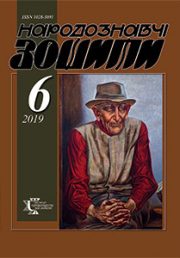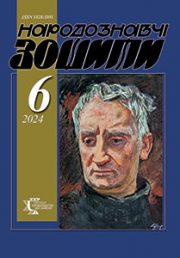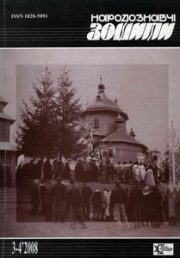The Ethnology Notebooks. 2022. № 2 (164), 391—400
UDK 81’37:398.21(430)]:82-92
DOI https://doi.org/10.15407/nz2022.02.391
SLOBODIAN Nazarii
- ORCID ID: https://orcid.org/0000-0001-6117-3958
- Master of Philology. Ph. D. candidate,
- Volodymyr Hnatiuk National Pedagogical University of Ternopil.
- Department of Theory and Methods of Ukrainian and World Literature,
- 2, Maxyma Kryvonosa str., 46000, Ternopil, Ukraine,
- Contacts: e-mail: nazariy.sln@gmail.com
Abstract. The study of the structure and the features of the semantics of the narrative in general is quite a difficult research task, especially considering the nature of the material. After all, we are dealing with texts that depict certain symbolic ideas of our contemporaries. Folklore about Germans and Germany is an integral part of oral folklore, which was formed through the prism of socio-political events that were the basis for its development and functioning. This branch of folklore began to expand especially actively during political and social cataclysms, such as the First and Second World Wars, waves of emigration and migrant labor. That is why nowadays there is a large number of different opinions, stereotypes and prejudices about Germans and Germany, which due to the social context and prevalence have become elements of folklore.
The subject of our study is a content component of stories about Germany and the Germans. The aim of the article is to explore the structural and semantic features of stories about Germany and Germans.
The study uses anthropological, comparative, systematic and statistical methods.
Analyzing the theoretical works of folklorists on this topic and analyzing the interviews, we can conclude that in narrative texts the image of a German and Germany can be revealed through a spatial model. This is clearly seen in the memorandum convention, which is characterized by the complexity of the plot, because the hero in it is both a participant and a witness of the event.
The analysis of our material shows that these narratives are characterized by two types of narrative: homodiegetic and heterodiegetic. The latter is usually represented by relatives or acquaintances.
The most common mythologem is the image of a «distant land», where everything is different than ours. That what makes us different the respondent tries to convey accurately and in detail, while clearly and vividly reproducing the personalities of people, their values, manner of speech, interpersonal relationships and stereotypes of everyday behavior.
Keywords: oral tradition, narrative, narratology, Germany, Germans, semantics.
Received 18.04.2022
REFERENCES
- Dei, O. (1983). Folklore records of Marko Vovchok and Opanas Markovych. Kyiv: Naukova dumka [in Ukrainian].
- Pobirchenko, N., & Kravchenko, O. (2009). Panteleimon Kulish: ethnographer, folklorist, literary critic. Uman: PP Zhovtyi [in Ukrainian].
- Drahomanov, M. (1970). Literary and journalistic works: in 2 volumes. Kyiv: Naukova dumka [in Ukrainian].
- Kyrchiv, R. (2008). Ivan Franko: spirit, science, thought, will: materials of the International Scientific Congress dedicated to the 150th anniversary of the birth of Ivan Franko. Lviv: Vyd. tsentr LNU im. Ivana Franka [in Ukrainian].
- Kuzelia, Z. (1994). Folk spiritual culture: Folk customs, folk art. Encyclopedia of Ukrainian Studies (Pp. 228—239). Kyiv [in Ukrainian].
- Hnatiuk, V. (2000). Essay on Ukrainian mythology. Lviv: In-t narodoznavstva NAN Ukrainy [in Ukrainian].
- Myshanych, S. (2003). Folklore and literary works (Vol. 1: General methodological aspects. Poetics of folk genres. Comparative studies). Donetsk: Donetsk National University [in Ukrainian].
- Myshanych, S. (2003). Folklore and literary works (Vol. 2: Literary studies. People’s avengers of Ukraine in folklore. Talented carriers and creators of folklore: to the problem of evolution of folklore tradition. From the history of Ukrainian folklore. Popular science articles). Donetsk: Donetsk National University [in Ukrainian].
- Kuzmenko, O. (2018). Dramatic human existence in ukrainian folklore: conceptual forms of expression (the period of XXI and XXII). Lviv: Instytut of Ethnology of the NAN of Ukraine [in Ukrainian].
- Labashchuk, O. (2013). Natal narrative and oral tradition: syntactics, semantics, pragmatics: monograph. Ternopil: Pidruchnyky i posibnyky [in Ukrainian].
- Bohdanov, K. (2001). Everyday life and mythology: research on the semiotics of folklore reality. Institute of Russian Literature (Pushkyn. dom) RAN, Otd. folklora. SPb.: Yskusstvo-SPB [in Russian].
- Hinda, O. (2015). Poetic creativity of the Ukrainian labor community in Italy at the beginning of the XXI century in the context of folklore tradition: monograph. Lviv: LNU of Ivan Franko [in Ukrainian].
- Bart, R. (1987). Introduction to the structural analysis of narrative texts. Foreign aesthetics and theory of literature of the XIX—XX centuries: treatises, articles, essays. Moscow: MHU [in Russian].
- Shmіd, V. (2003). Narratology. Moscow: Languages of Slavic Culture [in Russian].
- Papusha, I. (2005). What is narratology? (review of the concept). Narrative dimensions of literature: materials of the international conference on narratology. Ternopil, Ukraine, October 23—24, 2003. Studia methodologica (Issue 16).Ternopil: Editorial and Publishing Department of TNPU [in Ukrainian].
- Kuzmenko, O. (2012). Episode as a structural dominant of folk narratives about the First World War. Retrieved from: https://nz.lviv.ua/archiv/2012-2/14.pdf [in Ukrainian].
- Emer, Yu. (2009). Folklore genre (on the problem of linguocognitive modeling). Questions of cognitive linguistics, 2, 107—116 [in Russian].
- Davydiuk, L. (2017). Narrative discourse of oral non-fiction stories. Science and Education a New Dimension. Philology (Vol. (39), issue 143) [in Ukrainian].
- Orteha-i-Hasset, Kh. (1992). Selected works. Kyiv: Osnovy [in Ukrainian].
- Kuriata, Yu. (2010). Problems of general and pedagogical psychology: Collection of scientific works (Pp. 225—232) [in Ukrainian].
- Dyserinck, H. (1977). Komparatistik. Eine Einfьhrung. Bonn: Bouvier [in German].
- Dunaievska, L. (1997). Ukrainian folk prose (legend, fairy tale). Evolution of epic traditions. Kyiv: Biblioteka ukraintsia [in Ukrainian].






